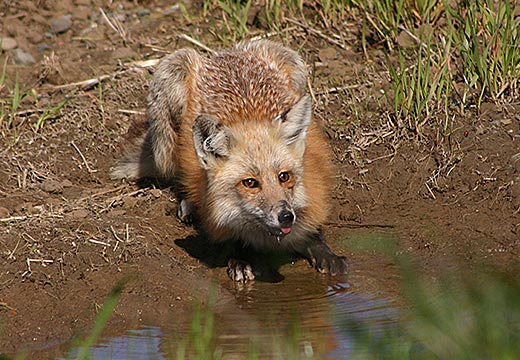Around the world in 400,000 years: The journey of the red fox

Genetic analysis by UC Davis scientists suggests red foxes, like this Sacramento Valley red fox, originated in the Middle East before beginning its journey of colonization across the world. (Ben Sacks/UC Davis Photo)
That’s what scientists studying the evolution of the red fox had been doing for decades. Now, University of California, Davis, researchers have for the first time investigated ancestry across the red fox genome, including the Y chromosome, or paternal line.
The data, compiled for over 1,000 individuals from all over the world, expose some surprises about the origins, journey and evolution of the red fox, the world’s most widely distributed land carnivore.
“The genome and the information it contains about our ancestry and evolution is huge,” said lead author Mark Statham, an assistant project scientist with the UC Davis Veterinary Genetics Laboratory. “If you’re only looking at what your mother’s mother’s mother did, you’re only getting a small portion of the story.”
The study, published in the latest issue of the journal Molecular Ecology, represents the most globally comprehensive work yet on the red fox.
Conventional thinking based on maternal genetics suggested that red foxes of Eurasia and North America composed a single interconnected population across the Bering land bridge between Asia and Alaska. In contrast, this new research shows that the red foxes of North America and Eurasia have been almost entirely reproductively isolated from one another for roughly 400,000 years. During this time, the North American red fox evolved into a new species distinct from its Old World ancestors.
The previous view was distorted by the maternal picture because a single female line transferred from Asia to Alaska about 50,000 years ago.
The new genetic research further suggests that the first red foxes originated in the Middle East before beginning their journey of colonization across Eurasia to Siberia, across the Bering Strait and into North America, where they eventually founded the North American population.
“That small group that got across the Bering Strait went on to colonize a whole continent and are on their own evolutionary path,” Statham said.
During the red foxes’ journey over millennia, ice sheet formation and fluctuating temperatures and sea levels offered periods of isolation and reconnection, impacting their global distribution. Statham said understanding the evolutionary history of the red fox can provide insight into how other species may have responded to climate change and those same environmental shifts.
The research effort, headed by Statham and Ben Sacks, associate adjunct professor and director of the UC Davis Mammalian Ecology and Conservation Unit, involved a network of collaborators and contributors from around the world and relied heavily on specimens in natural history museums.
The study received primary funding from the Systematic Research Fund through the Systematics Association of the Linnean Society of London and the Veterinary Genetics Laboratory at UC Davis.
UC Davis is a global community of individuals united to better humanity and our natural world while seeking solutions to some of our most pressing challenges. Located near the California state capital, UC Davis has more than 34,000 students, and the full-time equivalent of 4,100 faculty and other academics and 17,400 staff. The campus has an annual research budget of over $750 million, a comprehensive health system and about two dozen specialized research centers. The university offers interdisciplinary graduate study and 99 undergraduate majors in four colleges and six professional schools.
- Read the full study.
- Download red fox photos.
- Related article: Fox spit helped Forest Service confirm rare find (2010)
- Related article: With public's help, team IDs 100 red foxes (2009)
- Mark Statham, UC Davis Veterinary Genetics Laboratory, (530) 754-7932, statham@ucdavis.edu
- Kat Kerlin, UC Davis News Service, (530) 752-7704, kekerlin@ucdavis.edu
Media Contact
All latest news from the category: Ecology, The Environment and Conservation
This complex theme deals primarily with interactions between organisms and the environmental factors that impact them, but to a greater extent between individual inanimate environmental factors.
innovations-report offers informative reports and articles on topics such as climate protection, landscape conservation, ecological systems, wildlife and nature parks and ecosystem efficiency and balance.
Newest articles

Nerve cells of blind mice retain their visual function
Nerve cells in the retina were analysed at TU Wien (Vienna) using microelectrodes. They show astonishingly stable behavior – good news for retina implants. The retina is often referred to…

State-wide center for quantum science
Karlsruhe Institute of Technology joins IQST as a new partner. The mission of IQST is to further our understanding of nature and develop innovative technologies based on quantum science by…

Newly designed nanomaterial
…shows promise as antimicrobial agent. Rice scientists develop nanocrystals that kill bacteria under visible light. Newly developed halide perovskite nanocrystals (HPNCs) show potential as antimicrobial agents that are stable, effective…



